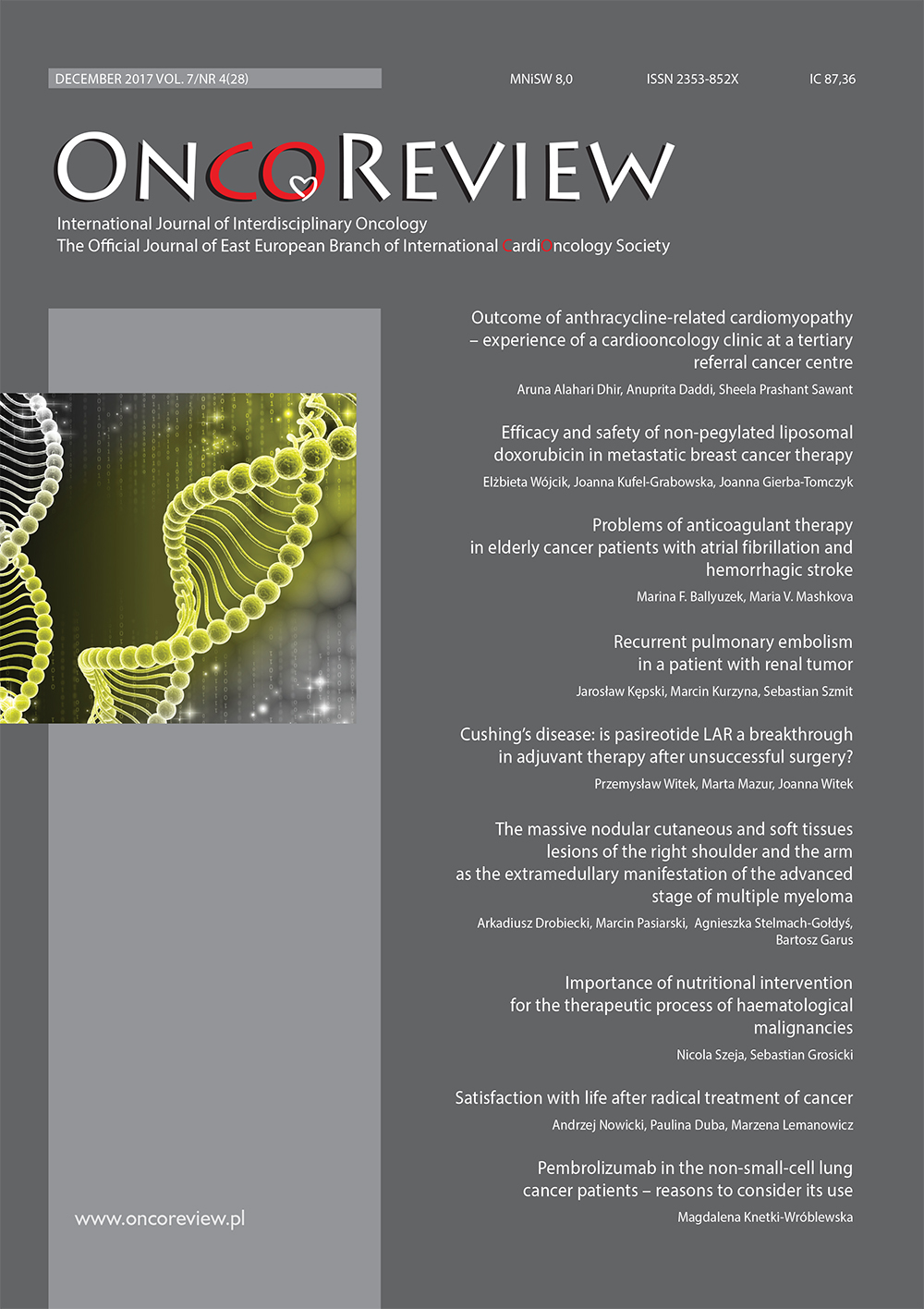Nawrotowa zatorowość płucna u chorego z guzem nerki Case report
##plugins.themes.bootstrap3.article.main##
Abstrakt
Żylna choroba zakrzepowo-zatorowa jest jedną z głównych przyczyn nagłych zgonów pacjentów hospitalizowanych. Wśród klasycznych czynników ryzyka szczególne miejsce zajmuje choroba nowotworowa. Nawet 20% chorych onkologicznych dotknie epizod zakrzepowo-zatorowy, a u 10% będzie stanowić bezpośrednią przyczynę zgonu. W opisanym przypadku u chorej z jednoczasowo rozpoznaną zatorowością płucną i guzem nerki doszło do dorzutu zatorowości pomimo optymalnego leczenia przeciwkrzepliwego. Taki scenariusz powikłań świadczy na ogół o istotnym klinicznie zaawansowaniu choroby nowotworowej, wiąże się z gorszym rokowaniem i wymaga zindywidualizowanego postępowania terapeutycznego.
Pobrania
##plugins.generic.paperbuzz.metrics##
##plugins.themes.bootstrap3.article.details##

Utwór dostępny jest na licencji Creative Commons Uznanie autorstwa – Użycie niekomercyjne 4.0 Międzynarodowe.
Copyright: © Medical Education sp. z o.o. This is an Open Access article distributed under the terms of the Attribution-NonCommercial 4.0 International (CC BY-NC 4.0). License (https://creativecommons.org/licenses/by-nc/4.0/), allowing third parties to copy and redistribute the material in any medium or format and to remix, transform, and build upon the material, provided the original work is properly cited and states its license.
Address reprint requests to: Medical Education, Marcin Kuźma (marcin.kuzma@mededu.pl)
Bibliografia
2. Levitan N, Dowlati A, Remick SC et al. Rates of initial and recurrent thromboembolic disease among patients with malignancy versus those without malignancy. Risk analysis using Medicare claims data. Medicine (Baltimore) 1999; 78(5): 285-291.
3. Heit JA. The Epidemiology of Venous Thromboembolism in the Community. Arteriosclerosis, Thrombosis, and Vascular Biology 2008; 28(3): 370- 372. https://doi.org/10.1161/ATVBAHA.108.162545.
4. Timp JF, Braekkan SK, Versteeg HH, Cannegieter SC. Epidemiology of cancerassociated venous thrombosis. Blood 2013; 122: 1712-1723.
5. Lecumberri R, Marques M, Panizo E et al. High incidence of venous thromboembolism despite electronic alerts for thromboprophylaxis in hospitalized cancer patients. Thromb Haemost 2013; 110: 184-190.
6. Lytvynets IA, Tomusiak TL. Body temperature reaction in different morphological forms of kidney cancer. Lik Sprava 1996; 5: 97-98.
7. Itsumi M, Tatsugami K. Immunotherapy for renal cell carcinoma. Clin Dev Immunol 2010; 2010: 284581.
8. Motzer RJ, Rini BI, McDermott DF et al. Nivolumab for Metastatic Renal Cell Carcinoma: Results of a Randomized Phase II Trial. J Clin Oncol 2015; 33(13): 1430-1437.
9. Konstantinides SV, Torbicki A, Agnelli G et al; Task Force for the Diagnosis and Management of Acute Pulmonary Embolism of the European Society of Cardiology (ESC): 2014 ESC guidelines on the diagnosis and management of acute pulmonary embolism. Eur Heart J 2014; 35(43): 3033-3069, 3069a-3069k.
10. Patel SH, Patel R. Inferior Vena Cava Filters for Recurrent Thrombosis: Current Evidence. Texas Heart Institute Journal 2007; 34(2): 187-194.
11. Workman CS, Lewandowski RJ, Desai KR. Techniques for Retrieval of Permanent Inferior Vena Cava Filters. Semin Intervent Radiol 2017; 34(2): 208-212.
12. Escudier B, Porta C, Schmidinger M et al.; ESMO Guidelines Working Group: Renal cell carcinoma: ESMO Clinical Practice Guidelines for diagnosis, treatment and follow-up. Ann Oncol 2014; 25(Suppl. 3): iii49-iii56.
13. Hutten BA, Prins MH, Gent M et al. Incidence of recurrent thromboembolic and bleeding complications among patients with venous thromboembolism in relation to both malignancy and achieved international normalized ratio: a retrospective analysis. J Clin Oncol 2000; 18(17): 3078-3083.
14. Parker WP, Cheville JC, Frank I et al. Application of the Stage, Size, Grade, and Necrosis (SSIGN) Score for Clear Cell Renal Cell Carcinoma in Contemporary Patients. Eur Urol 2017; 71(4): 665-673.
15. Rabinovitch RA, Zelefsky MJ, Gaynor JJ, Fuks Z. Patterns of failure following surgical resection of renal cell carcinoma: implications for adjuvant local and systemic therapy. J Clin Oncol 1994; 12(1): 206-212.
16. Meyer G, Marjanovic Z, Valcke J et al. Comparison of low-molecular-weight heparin and warfarin for the secondary prevention of venous thromboembolism in patients with cancer: a randomized controlled study. Arch Intern Med 2002; 162(15): 1729-1735.
17. White RH, Chew HK, Zhou H et al. Incidence of Venous Thromboembolism in the Year Before the Diagnosis of Cancer in 528 693 Adults. Arch Intern Med 2005; 165(15): 1782-1787.
18. Ahlbrecht J, Dickmann B, Ay C et al. Tumor grade is associated with venous thromboembolism in patients with cancer: results from the Vienna Cancer and Thrombosis Study. J Clin Oncol 2012; 30(31): 3870-3875.
19. Sorensen HT, Svarke C, Farkas DK et al. Superficial and deep venous thrombosis, pulmonary embolism and subsequent risk of cancer. Eur J Cancer 2012; 48(4): 586-593.
20. Van Doormaal FF, Terpstra W, Van Der Griend R et al. Is extensive screening for cancer in idiopathic venous thromboembolism warranted? J Thromb Haemost 2011; 9(1): 79-84.

